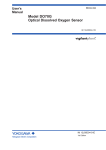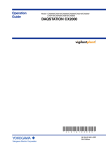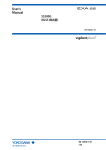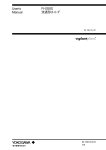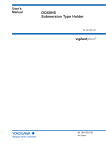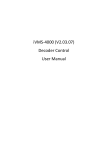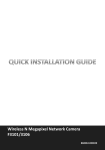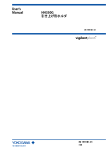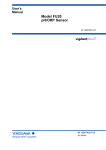Download SS300G MLSS Detector
Transcript
User’s Manual SS300G MLSS Sensor IM 12E6C1-01E R IM 12E6C1-01E 3rd Edition i <Introduction> Introduction The SS300G MLSS Sensor is designed for use in the SS400 MLSS Metering System in combination with an SS400G MLSS Converter and Holder. The SS300G MLSS Sensor uses transmitted and scattered light comparison as the measurement principle, covering a wide measurement range, from 500 to 20000 mg/l. This sensor is suited for continuous measurement of MLSS in activated sludge treatment processing in sewage or industrial waste treatment facilities. Because the system can be used for the measurement of suspended solids in treated water, this sensor can also serve as a MLSS meter for drain treatment facilities. This manual covers all of the information for handling the SS300G MLSS sensor, including installation, wiring, inspection and maintenance of this product. Note:Description of the entire MLSS metering system is in the SS400G MLSS Converter user’s manual (IM 12E6B1-02E): refer to the user’s manual for details. See the relevant manual for information on the holder that contains the SS300G MLSS sensor and the SS400G MLSS converter to which the sensor cable is connected. User’s Manuals for the EXA ss series SS400 MLSS metering system-related equipment are as follows. Manuals for associated equipment used with the EXA ss series SS400 MLSS metering system Model Title of Manual Publication no. SS400G MLSS Converter IM 12E6B1-02E SS350G Wiper Cleaning Controller IM 12E6E1-01E SS380G Calibration Kit IM 12E6D1-01E PH8HG Guide Holder IM 12B7M2-01E HH350G Well Bucket Type Holder IM 19H1B1-01E FH350G Flow-Through Type Holder IM 19H1C2-01E DOX8HS Submersion Type Holder IM 19H1D2-01E PB350G Float Type Holder IM 19H1E1-01E PB360G Vertical Float Type Holder WTB10-SS Terminal Box IM 19H1E2-01E IM 12E06W03-01E 1. Specification check Upon taking receipt of the product, unpack carefully, checking that no damage has occurred during transport. Each SS300G MLSS sensor is manufactured to user specifications. Check to ensure that the received product was manufactured to specification and that no accessories are missing. Verification of specifications can be made by confirming the model code indicated on the nameplate. For a description of the model codes, see Section 1.2.2. Media No.IM 12E6C1-01E 3nd Edition :Apr. 2015 (YK) All Rights Reserved Copyright © 1998, Yokogawa Electric Corporation IM 12E6C1-01E 3rd Edition : Apr.17, 2015-00 ii <Introduction> For the safe use of this equipment n Safety, Protection, and Modification of the Product • In order to protect the system controlled by the product and the product itself and ensure safe operation, observe the safety precautions described in this user’s manual. We assume no liability for safety if users fail to observe these instructions when operating the product. • If this instrument is used in a manner not specified in this user’s manual, the protection provided by this instrument may be impaired. • Be sure to use the spare parts approved by Yokogawa Electric Corporation (hereafter simply referred to as YOKOGAWA) when replacing parts or consumables. • Modification of the product is strictly prohibited. • The following symbols are used in the product and user’s manual to indicate that there are precautions for safety: n Notes on Handling User’s Manuals • Please hand over the user’s manuals to your end users so that they can keep the user’s manuals on hand for convenient reference. • Please read the information thoroughly before using the product. • The purpose of these user’s manuals is not to warrant that the product is well suited to any particular purpose but rather to describe the functional details of the product. • No part of the user’s manuals may be transferred or reproduced without prior written consent from YOKOGAWA. • YOKOGAWA reserves the right to make improvements in the user’s manuals and product at any time, without notice or obligation. • If you have any questions, or you find mistakes or omissions in the user’s manuals, please contact our sales representative or your local distributor. n Warning and Disclaimer The product is provided on an “as is” basis. YOKOGAWA shall have neither liability nor responsibility to any person or entity with respect to any direct or indirect loss or damage arising from using the product or any defect of the product that YOKOGAWA can not predict in advance. IM 12E6C1-01E 3rd Edition : Apr.17, 2015-00 iii <Introduction> n Symbol Marks Throughout this user’s manual, you will find several different types of symbols are used to identify different sections of text. This section describes these icons. WARNING Indicates a potentially hazardous situation which, if not avoided, could result in death or serious injury. CAUTION Indicates a potentially hazardous situation which, if not avoided, may result in minor or moderate injury. It may also be used to alert against unsafe practices. IMPORTANT Indicates that operating the hardware or software in this manner may damage it or lead to system failure. NOTE Draws attention to information essential for understanding the operation and features. Tip This symbol gives information that complements the current topic. SEE ALSO This symbol identifies a source to be referred to. IM 12E6C1-01E 3rd Edition : Apr.17, 2015-00 iv <Introduction> After-sales Warranty During the warranty period, for repair under warranty carry or send the product to the local sales representative or service office. Yokogawa will replace or repair any damaged parts and return the product to you. Before returning a product for repair under warranty, provide us with the model name and serial number and a description of the problem. Any diagrams or data explaining the problem would also be appreciated. If we replace the product with a new one, we won’t provide you with a repair report. Yokogawa warrants the product for the period stated in the pre-purchase quotation. Yokogawa shall conduct defined warranty service based on its standard. When the customer site is located outside of the service area, a fee for dispatching the maintenance engineer will be charged to the customer. In the following cases, customer will be charged repair fee regardless of warranty period. • Failure of components which are out of scope of warranty stated in instruction manual. • Failure caused by usage of software, hardware or auxiliary equipment, which Yokogawa Electric did not supply. • Failure due to improper or insufficient maintenance by user. • Failure due to modification, misuse or outside-of-specifications operation which Yokogawa does not authorize. • Failure due to power supply (voltage, frequency) being outside specifications or abnormal. • Failure caused by any usage out of scope of recommended usage. • Any damage from fire, earthquake, storms and floods, lightning, disturbances, riots, warfare, radiation and other natural changes. Yokogawa does not warrant conformance with the specific application at the user site. Yokogawa will not bear direct/indirect responsibility for damage due to a specific application. Yokogawa Electric will not bear responsibility when the user configures the product into systems or resells the product. Maintenance service and supplying repair parts will be covered for five years after the production ends. For repair for this product, please contact the nearest sales office described in this instruction manual. IM 12E6C1-01E 3rd Edition : Apr.17, 2015-00 i <CONTENTS> Model SS300G MLSS Sensor IM 12E6C1-01E 3nd Edition CONTENTS Introduction...............................................................................................................i For the safe use of this equipment....................................................................ii After-sales Warranty...........................................................................................iv 1.Overview..................................................................................................... 1-1 1.1 Features of the SS300G MLSS Sensor............................................................ 1-1 1.2 Specifications..................................................................................................... 1-2 1.2.1 Standard Specifications...................................................................... 1-2 1.2.2 Model and Codes................................................................................ 1-3 1.2.3 External Dimensions........................................................................... 1-3 2. Components and Functions.................................................................... 2-1 3. Installation and Wiring.............................................................................. 3-1 3.1Installation.......................................................................................................... 3-1 3.2 3.1.1 Selecting Measuring Point.................................................................. 3-1 3.1.2 Selecting a Holder............................................................................... 3-1 3.1.3 Installing the Sensor........................................................................... 3-2 Wiring.................................................................................................................. 3-6 3.2.1 Sensor Cable Specifications............................................................... 3-6 3.2.2 Connecting the Sensor Cable............................................................. 3-6 4.Operation.................................................................................................... 4-1 4.1 4.2 Preparation......................................................................................................... 4-1 4.1.1 Inspection of Installation and Wiring................................................... 4-1 4.1.2 Inspecting Measurement.................................................................... 4-1 Steady Operation............................................................................................... 4-1 4.2.1 When Failures Occur.......................................................................... 4-1 4.2.2 Cautions on Operation [Stopping and Restarting].............................. 4-1 5.Maintenance............................................................................................... 5-1 5.1 Daily Inspection.................................................................................................. 5-1 5.1.1 Cleaning the Sensor........................................................................... 5-1 5.1.2 Inspecting the Nut Used to Secure the Prism Assembly.................... 5-1 5.1.3 Inspecting the Sealing O-ring............................................................. 5-1 5.1.4 Inspecting the Cleaning Device.......................................................... 5-2 IM 12E6C1-01E 3rd Edition : Apr.17, 2015-00 ii <CONTENTS> 5.2 Inspection for Failure Occurrence................................................................... 5-2 5.2.1 Inspecting the Prism Assembly........................................................... 5-2 5.2.2 Inspecting the Prism Assembly Seal Section..................................... 5-2 5.2.3 Inspecting the Insulation Performance of the Sensor Main Unit........ 5-2 Customer Maintenance Parts LIST.....................................CMPL 12E06C01-01E Revision Information................................................................................................i IM 12E6C1-01E 3rd Edition : Apr.17, 2015-00 1-1 <1. Overview> 1.Overview This chapter describes the specifications of the SS300G MLSS Sensor. 1.1 Features of the SS300G MLSS Sensor • This sensor is capable of a broad range of measurements, from low to high concentration, and provides stable performance over an extended period of time. Because the transmitted and scattered light comparison method is used for measurement, this sensor covers a wide range of measurement, from 500 mg/l to 20000 mg/l, and is suitable for the measurement of install sewage SS to return sludge MLSS, as well as MLSS in aeration tanks. The use of this measurement method means that the sensor is not easily influenced by changes in light source, staining or coloring. • This sensor is not easily influenced by external light reflected from the interface Because the sensor employs a photodiode and light source that operates in the near infrared, the growth of organic pollution such as photosynthesis-fed algae is suppressed. Also, use of pulse lighting for the light source and the attachment of a visible light cut filter reduces the influence of external light. In addition, the optical system (light source, photodiode, etc.) is designed not to be influenced by light reflected from the interface of the solution to be measured. • This compact and light sensor permits easy maintenance and, by combining it with a variety of holders and cleaning devices, maintenance frequency can be reduced. Compared to conventional products, this sensor is significantly smaller, both in terms of physical size and weight, and previously troublesome replacement of the light source is essentially eliminated. The addition of an optional jet cleaning devices makes it possible to automatically perform periodic cleaning, reducing maintenance frequency. The unit can be combined with suitable holders, including floating type holders, making highly reliable measurement a reality. F1101.ai Figure 1.1 Overview of the SS300G MLSS Sensor IM 12E6C1-01E 3rd Edition : Apr.17, 2015-00 1-2 <1. Overview> 1.2 Specifications 1.2.1 Standard Specifications Shape: Probe-like Sensor Measurement subjects: Concentration of mixed liquor suspended solids (MLSS) in an aeration tank in a sewage or industrial wastewater treatment plant. Note: MLSS analyzer can not be used for measurement of suspended solids (SS) concentration in effluent after aeration treatment, neutralization facilities, and seawater. When a guide-pipe type sensor is used in excreta disposal facilities, the cable must not come in contact with the liquid. Consult with Yokogawa. Measuring principle: Transmitted and scattered lightcomparison Measuring Range: 500 - 20000 mg/L (kaolin standard) Temperature of measured subjects: 0 - 50°C Pressure of measured subjects: 0 - 200 kPa pH of measured objects: pH 6 to 8 Flow velocity: 0.2 to 1 m/sec (depending on holder) Cable length: 3, 5, 10, 15 or 20 m (when terminal box used, maximum cable length is 50 m within sensor cable length.) . Material of wetted part or junction: Body; Window; O-ring; Cable; Weight: Stainless steel (SUS304 or equivalent) glass nitrile rubber PVC Approximately 0.5 kg plus N x 0.12 kg, where N is cable length m. Cleaning unit (optional): Jet cleaning Note: No cleaning unit can be used if the sensor is equipped with a floating ball holder. Material of jet cleaning unit; Polypropylene, polyethylene and SUS304 (wetted part) Utilities of jet cleaning; Pressure; water jet 100 to 200 kPa air jet 100 to 200 kPa Flow rate; water jet 5 to 20 L/mim air jet 10 to 20 NL/min [Characteristics] Linearity: ±4.5% F.S. (by stable kaolin solution) Repeatability: 2% F.S. (by calibration plate) Stability: Zero ± 2% F.S./day (by city water) Span ± 2% F.S./day (by calibration plate) Note F.S. means upper setting value of output range. IM 12E6C1-01E 3rd Edition : Apr.17, 2015-00 1-3 <1. Overview> 1.2.2 Model and Codes Model SS300G — Cable length Treatment on cable ends Suffix code -------NN -03 -05 -10 -15 -20 -PN Options: Cleaning unit Option code ----------------------------------------------------------------- [Style : S2] Pin terminals Rc1/2 * connection with jet cleaning unit (female thread) 1/2NPT * connection with jet cleaning unit Hardware for free-standing installation /JTJ /JTA /MS Bracket MLSS Sensor Always "NN" 3m 5m 10 m 15 m 20 m Description * Choose this option if a holder is used. 1.2.3 External Dimensions Unit: mm Ø32 Ø36 46 Ø26 10 154 Cable length of 3, 5, 10, 15 or 20 m as standard F1201.ai Figure 1.2 SS300G MLSS Sensor IM 12E6C1-01E 3rd Edition : Apr.17, 2015-00 1-4 <1. Overview> Unit: mm 600 max. 500 55 min. 236 pitch 44 65 JIS 50A 2-inch stanchion (vertical) Suspension wire (max. 5 m) F1201.ai Figure 1.3 Free-standing Installation (Drop-in Mount) Bracket IM 12E6C1-01E 3rd Edition : Apr.17, 2015-00 1-5 <1. Overview> Unit: mm 600 Hose for cleaning (max. 10 m) max. 500 55 min. 236 pitch 44 Suspension wire (max. 5 m) 65 JIS 50A 2-inch stanchion (vertical) Approx. 271 Approx. 105 Figure 1.4 84 F1203.ai Jet-Washing Device IM 12E6C1-01E 3rd Edition : Apr.17, 2015-00 Blank Page 2. 2-1 <2. Components and Functions> Components and Functions This chapter describes the external appearance of the SS300G MLSS sensor and items to note when handling the sensor. Prism assembly Measuring window section O-ring Securing nut Securing nut Sensor main body Contains light emitting devices and a photodetector. Transmitted and scattered light are detected and converted to electric signals. Sensor cable Carries sensor signals to the MLSS sensor. The desired cable length can be selected from 3, 5, 10, 15 and 20 meters. Prism assembly Contains an optical system that exposes the solution to be measured to light and directs transmitted and scattered light to the sensor. Name plate Contains the specific sensor constant for each sensor. Figure 2.1 F2001.ai SS300G MLSS Sensor CAUTION Be careful not to scratch the measuring window section of the prism assembly. If the window is scratched, the sensor constant may change, requiring re-calibration of the solution to be measured, or in the worst case, replacement of the prism assembly. Be sure not to loosen the securing nut except when replacing the prism assembly. IM 12E6C1-01E 3rd Edition : Apr.17, 2015-00 Blank Page 3. 3-1 <3. Installation and Wiring> Installation and Wiring The SS300G MLSS sensor is used in conjunction with a drop-in mounting bracket or is incorporated in a holder. This chapter describes installation and wiring (connection of the sensor cable) for the SS300G. 3.1Installation Normally, the SS300G MLSS sensor is incorporated in the PH8HG guide holder, DOX8HS submersion type holder, HH350G well bucket type holder, PB350G float type holder, or PB360G vertical float holder and submerged for measuring. It is also possible to use the drop-in mounting bracket (option) for direct submergence in the measuring process. This section explains items to note when selecting both the installation location for the SS300G and the holder to be used. 3.1.1 Selecting Measuring Point Install the sensor at an appropriate location where the typical measured value of the measurement subject can be obtained. To obtain an accurate MLSS value. • Maintain a 7 cm distance between the tip of the sensor and walls or other obstacles. • When the solution to be measured generates an interface, maintain a 7 cm distance between the tip of the sensor and the interface. • Do not expose the measuring window section of the sensor to strong tight such as sunlight. In addition, the temperature and pressure of the solution to be measured must conform to SS300G specifications. With regard to maintenance (cleaning, calibration), easy access should be taken into consideration when installing the sensor. Note: There may be restriction on the installation location depending on the type of holder used. See the holder instruction manual for details. 3.1.2 Selecting a Holder The holders that contain the SS300G MLSS sensor have the following characteristics, respectively. Select a holder according to such conditions as the property of the solution to be measured and the measurement location. [Drop-in type (option)] This holder can be easily installed by simply hanging the sensor from the drop-in mounting bracket (option) using a wire. This type is appropriate for low flow speed applications. Automatic cleaning can be performed using the jet-washing device (option); however, because the sensor is not held in the flow direction, this holder is not appropriate for those cases that have a fast flow speed. Note: The drop-in mounting bracket is attached upon request. It is also attached when a jet-washing device is requested. [PH8HG Guide Pipe] This holder suspends the sensor in a pipe made of polyvinyl chloride resin. This simple method is appropriate for applications that require more than simple mounting and that do not require automatic cleaning. Installing the guide holder at about a 20° angle prevents stagnation of bubbles at the sensor measuring window section. IM 12E6C1-01E 3rd Edition : Apr.17, 2015-00 3-2 <3. Installation and Wiring> [DOX8HS Submersion Type Holder] This holder holds the sensor firmly even through the flow speed is fast and measurement can be performed at a constant measuring point. Because the sensor is held at 45°, stagnation of bubbles at the sensor measuring window section are prevented. [HH350G Well Bucket Type Holder] This holder can move the sensor up and down along the angle pipe guide holder. During measurement, a chain is used to lower the sensor to the desired depth. Even when in a deep tank, maintenance can easily be performed by using a wire to lift the sensor. Automatic cleaning using the jet-washing device (option) is available. [PB350G Float Type Holder, PB360G Vertical Type Float Holder] This type of holder incorporates the holder in a spherical shape float that rides on top of the solution to be measured. This holder can handle great changes in the surface of the solution. Because the float is supported by an am, the measuring point does not move in the solution flow. Also, because of its spherical shape, the sensor section does not get dirty easily. This type is suitable for applications that have regular, constant flow. CAUTION Installation Location of Holders (Guide Pipe, Submersion Type, etc) The holder should be used in a place that is as vibration free as possible. Using the holder in a place where it is affected by vibration, may result in damage to the holder. 3.1.3 Installing the Sensor The sensor can be installed by incorporation in a holder or by using a drop-in mounting bracket (option). [Incorporation in Holder] For incorporation of the sensor in a holder and holder installation, see the concerned holder instruction manual. Use care with regard to sensor orientation. Taking the holder installation into consideration, incorporate the sensor in the holder so that the mounting orientation mark (sensor flat cut part) on the sensor is parallel to the flow of the solution to be measured. IM 12E6C1-01E 3rd Edition : Apr.17, 2015-00 <3. Installation and Wiring> 3-3 MLSS sensor Mounting orientation mark (flat notched section) Solution flow direction Solution flow direction [Correct installation] [Incorrect installation] F3101.ai Figure 3.1 Installation orientation of MLSS Sensor [Installation by Drop-in Mounting Bracket] Install the sensor according to the following procedure. (1) Attach the drop-in mounting bracket to a sufficiently strong, (2-inch pipe), as shown in Figure 3.2. Nominal size 50 A (2-inch) vertical pipe U bolt Drop-in mounting bracket Nut Washer F3102.ai Figure 3.2 Attaching the drop-in mounting bracket IM 12E6C1-01E 3rd Edition : Apr.17, 2015-00 3-4 <3. Installation and Wiring> (2) Cut the wire to an appropriate length based on the submerge depth of the sensor. (3) As shown in Figure 3.3, assemble the wire hanging bracket and pass one end of the wire through the securing pipe and secure it using the dedicated nut. After hand-tightening the butterfly nut on the U bolt, use a pair of pliers to strip the threads of the screw at the tip of the bolt. Pipe used to secure wire Bracket used to hang wire Nut: secure Butterfly nut: hang tighten U bolt Washer Wire Approx. 30 mm Dedicated nut used to secure wire F3103.ai Figure 3.3 Assembling the Wire Hanging Bracket (4) As shown in Figure 3.4, incorporate the sensor in the securing bracket or cleaning device and pass one end of the wire through the securing bracket and secure it with the dedicated nut. Note: Be sure that the sensor is correctly oriented. IM 12E6C1-01E 3rd Edition : Apr.17, 2015-00 3-5 <3. Installation and Wiring> Clamp Connection joint (Rc1/2 or 1/2NPT) Sensor cable Pipe to secure wire Bracket to hang wire Sensor cable Pipe to secure wire Bracket to hang wire Net-impregnated Soft polyvinyl chloride resin hose Wire Dedicated nut used to secure wire Clamp Dedicated nut used to secure wire Nut to secure sensor 30 mm Wire Jet-washing device Butterfly nut Sensor mounting orientation mark (flat notched section) U bolt Washer Bracket to secure sensor Sensor mounting orientation mark (flat notched section) [Without jet-washing device] [With jet-washing device] Figure 3.4 Incorporating the Sensor (5) To attach a jet-washing device, connect it to the attached net-impregnated soft polyvinyl chloride resin hose and use a clamp to secure it. Pass one end of the hose through the wire securing pipe and then connect it to the attached connection joint and secure it with a clamp (see Figure 3.4). With other than the jet-washing device, pass the sensor cable through the wire securing pipe. (6) Once the sensor is hung, attach the wire hanging bracket at any position on the drop-in mounting bracket and use the U bolt to secure it. When performing sensor maintenance, loosen the butterfly nut of the wire hanging bracket and remove the sensor together with the hanging bracket. IM 12E6C1-01E 3rd Edition : Apr.17, 2015-00 F3104.ai 3-6 <3. Installation and Wiring> Drop-in mounting bracket Wire hanging bracket Butterfly nut: secure F3105.ai Figure 3.5 Attaching the Drop-in Mounting Bracket NOTE While incorporating the sensor, use care to keep the terminal treatment section of the sensor cable from being stained or getting wet. Use care not to scratch the measuring window section of the sensor during installation. SEE ALSO For installation to the PH8HG, DOX8HS, HH350G, PB350G, and PB360G holders, refer to relevant user’s manuals. 3.2 Wiring The SS300G sensor cable is connected to the terminal of the SS400G converter (or relay terminal box). 3.2.1 Sensor Cable Specifications Cable length: 3, 5, 10, 15 or 20 m Cable diameter: Approx. 7 mm Temperature range: -10 to 60 °C Terminal treatment: Pin terminal 3.2.2 Connecting the Sensor Cable The sensor requires maintenance (calibration, cleaning). Consideration must be given with regard to the installation location so that maintenance work, including removal of the sensor, can be performed without difficulty. IM 12E6C1-01E 3rd Edition : Apr.17, 2015-00 3-7 <3. Installation and Wiring> [Guide to Cable Installation] Before connecting the sensor cable to the converter (or relay terminal box), check that the cable passes through the pipe of the holder and the sensor securing nut. Next, connect the cable to the correct terminals according to the mark band (11 to 19) indicated on each core wire. After connecting the cable, firmly tighten the cable gland to ensure its waterproof performance. For detailed wiring information, see the Instruction Manual for the SS400G MLSS converter (IM 12E6B1-02E) or WTB10-SS¨ terminal box (IM 12E06W03-01E). Connecting directly to the converter SS400G MLSS converter SS300G MLSS sensor 18 17 16 15 14 13 12 11 18 17 16 15 14 13 12 11 19 G 19 Sensor cable Connecting to a relay terminal box SS400G MLSS converter WTB10-SS1 relay terminal box 19 18 19 18 17 16 15 14 13 12 11 G 17 16 15 14 18 17 16 15 14 13 12 11 19 13 12 11 19 18 17 16 15 14 13 12 11 Dedicated extension cable Figure 3.6 19 18 SS300G MLSS sensor 17 16 15 14 13 12 11 Sensor cable F3201.ai Connecting the sensor cable CAUTION When connecting the sensor cable to the converter (or re]ay terminal box), be certain the wiring scheme is correct; failure to correctly wire the sensor may result in the failure of the device. IM 12E6C1-01E 3rd Edition : Apr.17, 2015-00 Blank Page 4-1 <4. Operation> 4.Operation Insure that the MLSS metering system is operating normally and is ready to perform desirable measurements before carrying out continuous operation. This chapter describes only those items that are related to the sensor. With respect to operation of the entire system, refer to the SS400G MLSS Converter User’s Manual (IM 12E6B1-02E) for details. 4.1 Preparation Before operating the sensor, check the installation state, wiring workmanship and movement. 4.1.1 Inspection of Installation and Wiring [Wiring] Insure that the sensor cables are installed correctly. • The terminal connected to the converter is firmly secured. • Maintenance (calibration and cleaning) can be carried out without difficulty. • There is no possibility of damage to the sensor cable. [Installation of the sensor] Insure that the sensor is installed correctly. • The sensor is correctly attached to the holder. • The sensor installation orientation and submerge depth are correct. • The sensor can be freely and safely removed. 4.1.2 Inspecting Measurement After making measurement parameter settings and calibration, operate the SS400G MLSS Converter, checking that the unit produces normal measurements. 4.2 • No error indication on the converter. • The indicated values on the converter are relatively close to those of recommended MLSS values. Steady Operation Maintain measurement accuracy by calibrating or cleaning the sensor periodically during steady operation. Details of sensor inspection and maintenance are explained in section 5. With respect to inspection and maintenance including calibration for the entire system, see the SS400G MLSS Converter User’s Manual (IM 12E6B1-02E). 4.2.1 When Failures Occur The converter detects measurement failures and errors due to the system failure, then outputs a FAIL contact signal. Should a failure be detected, take prompt countermeasures after consulting the User’s Manual. 4.2.2 Cautions on Operation [Stopping and Restarting] If it is expected that the sensor will be exposed to air over along period without operating, clean off any contamination that is adhering to the sensor. When operation is resumed, for caution’s sake, first perform simple calibration. IM 12E6C1-01E 3rd Edition : Apr.17, 2015-00 Blank Page 5-1 <5. Maintenance> 5.Maintenance This chapter describes inspection and maintenance of the MLSS sensor only. With respect to the general inspection and adjustment of the measuring system. Including calibration, refer to the SS400G MLSS Converter User’s Manual (IM 12E6B1-02E). It is recommended that the inspections and maintenance described in this chapter be carried out in accordance with the operational status of the individual sensor. 5.1 Daily Inspection 5.1.1 Cleaning the Sensor Contamination stuck to the measuring window of the MLSS sensor blocks measurement light, causing errors in the measured values. Even though periodic automatic cleaning is performed when the unit is fitted with a cleaning device, depending on the measuring conditions for the specific device dirt may accumulate on the device anyway. Therefore, visually check the measuring window section of the sensor occasionally and clean if it is contaminated. [Standard Cleaning Cycle] The cleaning cycle depends on the measuring conditions and whether or not a cleaning device is used; clean at least once every 1 to 2 months. [Guide to Cleaning] Pull up the sensor and dip the sensor body in clean water. Next use a soft material such as tissue paper to remove stains. For stains stuck on the measuring window section, use soft cloth, tissue paper or Q-tip cotton swabs to remove them. If it proves difficult to remove stains, use a cloth soaked in a diluted neutral detergent to remove. After cleaning, thoroughly rinse the unit with water. CAUTION Do not use a hard tool such as a brush to scrub the measuring window section. Doing so will likely scratch the measuring window. (When using a detergent, observe the cautions indicated on the container.) 5.1.2 Inspecting the Nut Used to Secure the Prism Assembly Each time cleaning or calibration is performed, check for loosening of nut used to secure the prism assembly. If found, tighten it. If the securing nut is extremely loose, for safety’s sake it is recommended that prism assembly seal section be inspected as described in Subsection 5.2.2. 5.1.3 Inspecting the Sealing O-ring Remove the prism assembly from the sensor main unit every 6 months and check for deterioration or deformation of the O-ring; if found, replace the O-ring. It is recommended that the O-ring be replaced periodically even if it is not visibly deteriorated or deformed. Replacing part number: K9432QD If solution to be measured is found inside the sensor during inspection, the sensor must be replaced. IM 12E6C1-01E 3rd Edition : Apr.17, 2015-00 5-2 <5. Maintenance> CAUTION Inspection by removing the prism assembly should not be performed more often than necessary; doing so shortens the service life of the O-ring. 5.1.4 Inspecting the Cleaning Device [Inspecting the Jet-Washing Nozzle] When cleaning or calibrating the sensor, check for clogging of the jet-washing nozzle. If the nozzle is clogged with dirt, clean the nozzle to remove. If doing so does not remove the dirt, detach the nozzle tip from the nozzle main unit to replace. Replacement part number: K9432RJ 5.2 Inspection for Failure Occurrence Sensor failure can be found by the existence of FAIL signals. Should an error occur, refer to the MLSS Converter User’s Manual (IM 12E6B1-02E) for details of appropriate measures to take. If the error indication continues after taking the indicated measures, inspect the sensor as described below. 5.2.1 Inspecting the Prism Assembly Check for scratches or damage on the measuring window section of the prism assembly; if found, the prism assembly must be replaced. After the prism assembly is replaced, perform solution calibration. Replacement part number: K9432PE 5.2.2 Inspecting the Prism Assembly Seal Section Detach the prism assembly from the sensor main unit and check for solution inside the sensor; if found, replace the sensor. 5.2.3 Inspecting the Insulation Performance of the Sensor Main Unit Disconnect the sensor from the converter and check that the insulation resistance between the bundle of the core (11 to 19) of the sensor cable and the sensor main unit (stainless steel) is 100 MΩ or more. If inspection determines that 100 MΩ or more insulation resistance cannot be obtained, replace the sensor. If the inspections described in Subsection 5.2.1 to 5.2.3 do not reveal any problem, it is possible that certain parts such as the light source and photo sensor have reached the end of their service life. If there is a spare sensor, attempt replacement of the sensor to determine whether the sensor is the cause of the problem. In any event, in such a case the sensor must be replaced. IM 12E6C1-01E 3rd Edition : Apr.17, 2015-00 Customer Maintenance Parts List Model SS300G MLSS Sensor 3 1 2 Option Code : / JTJ, / JTA Jet-Washing Unit Option Code : / WP Wiper-Washing Unit 5 4 Item 1 2 3 4 5 Part No. K9432PD K9432QD K9432PE K9432RJ K9432SF Qty 1 1 1 1 1 Description Box Nut O-Ring Prism Assembly Nozzle (For Jet-Washing Unit) Wiper (For Wiper-Washing Unit) All Rights Reserved, Copyright © 1997, Yokogawa Electric Corporation. Subject to change without notice. CMPL 12E06C01-01E 3rd Edition : Apr. 2001 (YK) i Revision Information SS300G MLSS Sensor Title: Manual No.: IM 12E6C1-01E Apr. 2015/3rd Edition Change Item 1.2.1 to GS 12E6A1-E description. Oct. 2013/2nd Edition Page layouted by InDesign Revised and Corrected over all of Style: 2, deletion of optional wiper cleaning (“/WP”); CMPL 12E06C01-01E revised to 3rd edition. Oct. 1998/1st Edition Newly published. n If you want to have more information about Yokogawa products, you can visit Yokogawa’s home page at the following web site. Home page: http://www.yokogawa.com/an IM 12E6C1-01E 3rd Edition : Apr.17, 2015-00 Blank Page































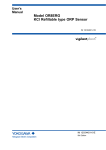

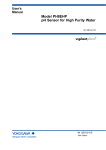
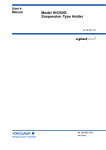

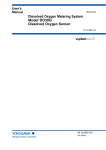

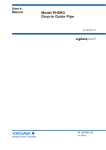
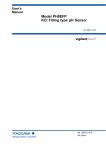
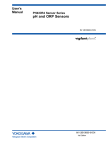
![SS400G MLSS Converter [Style:S2.2]](http://vs1.manualzilla.com/store/data/005726371_1-b873ef07ceb169a0226d293b313a67fd-150x150.png)
